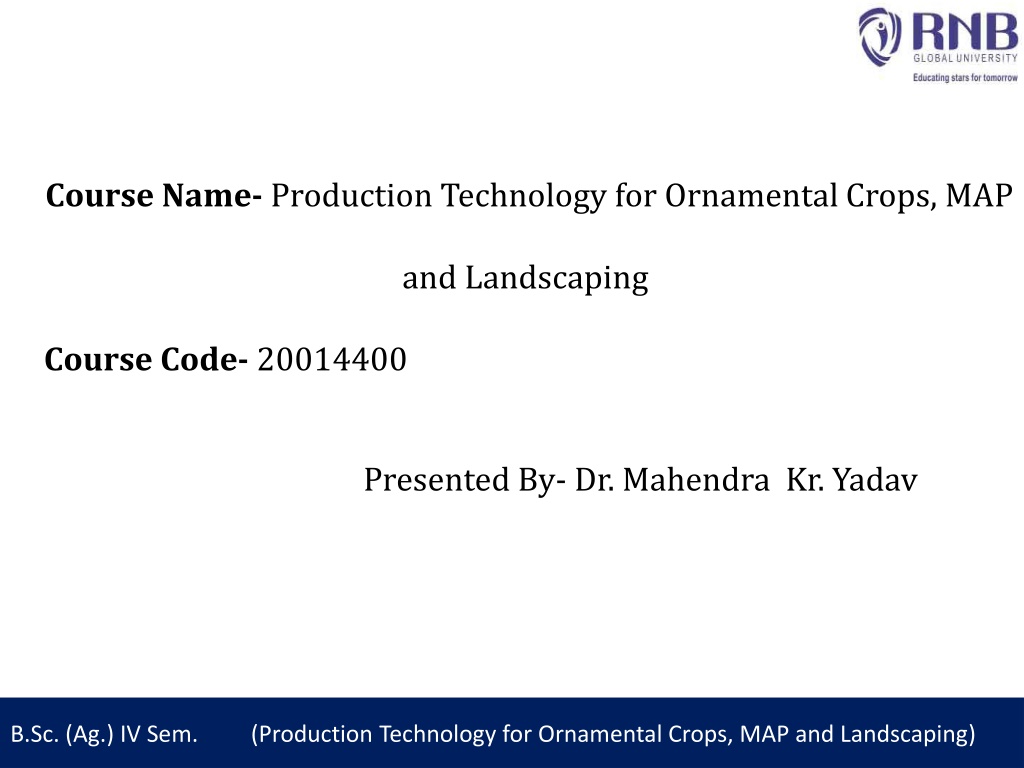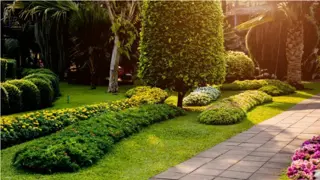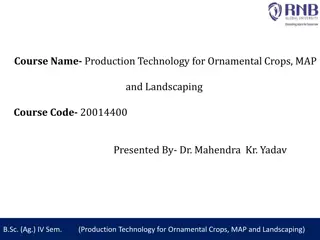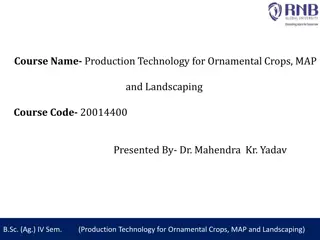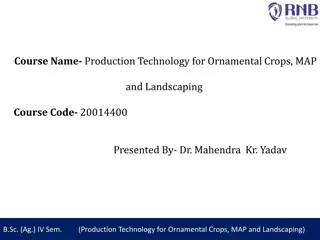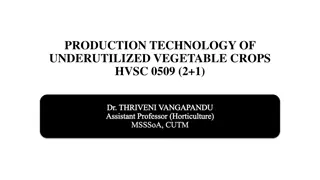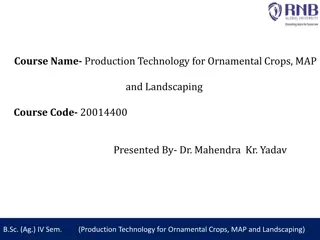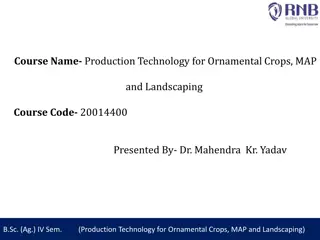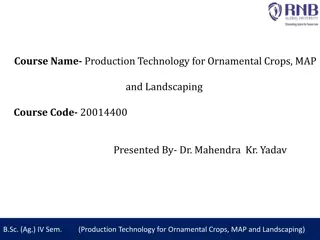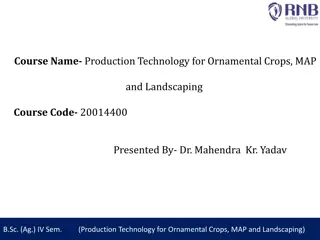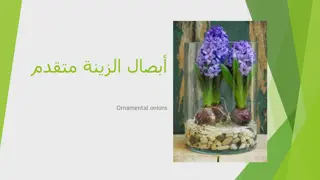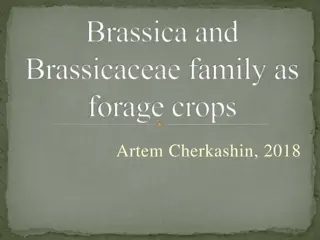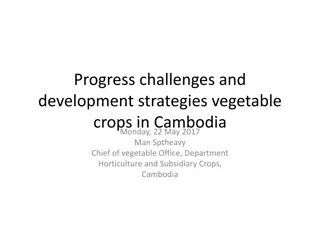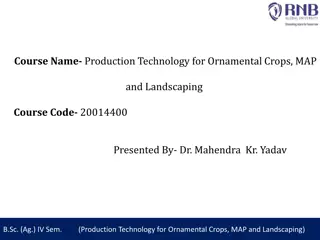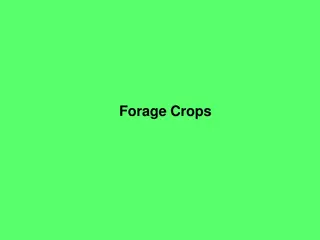Production Technology for Ornamental Crops and Landscaping - Course Overview
This course covers the production technology for ornamental crops, MAPs, and landscaping, presented by Dr. Mahendra Kr. Yadav. Learn about identifying different types of ornamental and medicinal crops, principles of landscaping, production techniques for important ornamental crops like orchids, and more. Dive into the specifics of orchid production, including types of orchids, ideal soil and climate conditions, planting distances, popular varieties, and propagation methods. Enhance your knowledge in the cultivation and maintenance of ornamental plants with this comprehensive course.
Download Presentation

Please find below an Image/Link to download the presentation.
The content on the website is provided AS IS for your information and personal use only. It may not be sold, licensed, or shared on other websites without obtaining consent from the author. Download presentation by click this link. If you encounter any issues during the download, it is possible that the publisher has removed the file from their server.
E N D
Presentation Transcript
Course Name- Production Technology for Ornamental Crops, MAP and Landscaping Course Code- 20014400 Presented By- Dr. Mahendra Kr. Yadav B.Sc. (Ag.) IV Sem. (Production Technology for Ornamental Crops, MAP and Landscaping)
Course Objectives Identify different types of ornamental and medicinal crops. Examine various principles of landscaping, uses of landscape trees, shrubs and climbers, production technology of important ornamental crops, etc. Determine about Demonstrate various Package of practices for loose flowers and their transportation, storage house and required condition for cut and loose flower. Construct about the various problems with the production technology of medicinal and aromatic plants. Importance of Processing and value addition in ornamental crops and MAPs produce. B.Sc. (Ag.) IV Sem. (Production Technology for Ornamental Crops, MAP and Landscaping)
Production technology of orchids B.Sc. (Ag.) IV Sem. (Production Technology for Ornamental Crops, MAP and Landscaping)
Production technology of orchids Botanical Name : Dendrobium sp. Cymbidium sp. Family : Orchidaceae Important genera: 1.Dendrobium 2. Cattleya, 3. Phalaenopsis 4. Cymbidium Importance and Uses: Important cut flower, more vase life They exhibits wide range of diversity in form, size, colour, & texture of flower. On plot it remain good for 1-3 months. Good indoor plant, grown in garden, pots, basket etc. Flowers are use in special functions B.Sc. (Ag.) IV Sem. (Production Technology for Ornamental Crops, MAP and Landscaping)
Types of orchid: 1. Sympodial type: Prostate rhizome whose growth terminates periodically with an upright pseudobulb, leaf & flowers eg Dendrobium, Cattleya, Cymbidium 2. Monopodial type: Form aerial roots from the stem as they are produced in their upward growth. Eg. Phalaenopsis Soil: Sandy loam soil with a pH of 5.5-6.5 is ideal. Climate: 75% green shade net with 70 - 80% humidity, 18 - 28 C temperature and light intensity of 1500-2000 foot candles is ideal for growing this tropical orchid. In high rainfall zones, the shade net house should be provided with a rain shelter. B.Sc. (Ag.) IV Sem. (Production Technology for Ornamental Crops, MAP and Landscaping)
Spacing and plant population: The planting distance is 45 cm x 45 cm, allowing roughly 29,640 plants/ha. Improved varieties: Cymbidium sp.: Levis Duke Bella Vista, Margaret Thatcher, Kennywine, Golden girl Mini Beacon Red torch, Beauty Fred 6, Ames Bury, Baltic Glacier Mint ice, Angelica Advent, Dingwall Lenes, Peter Pan Greenleaves. Dendrobium sp.: Sonia 17, Sonia 28, Emma White, Sakura Pink, Hieng Beauty, Renapa, Dorine White, Kasem White, Kasem Gold, PM-11, Waipahu Beauty, Sarifa Fatimah, Walter omae, Jiad Gold, Mme Vipar. Propagation: Propagation: Division of clumps, back bulbs and tissue culture plants. Planting Density of Orchids: 100,000-150,000plants/ha. B.Sc. (Ag.) IV Sem. (Production Technology for Ornamental Crops, MAP and Landscaping)
Manures and fertilizers Foliar application of N:P:K as 30:10:10 @ 0.05% on the plant and potting materials at an interval of 15 days during 1st year (young plants stage). For intermediate growth stage (2nd year ) foliar apply 20:20:20 of NPK @ 0.05% at an interval of 15 days. At late growth stages (3rd year on word) apply N, P, K as 15:25:25@ 0.1% at an interval of 15 days. Irrigation Mist or overhead sprinkler to provide water and to maintain humidity. Weed Management: Weeds in the orchid pots can be easily managed manually by picking through hand and single tooth fork. Containers and support : perforated earthen pots are ideal and the plants are staked with bamboo sticks. B.Sc. (Ag.) IV Sem. (Production Technology for Ornamental Crops, MAP and Landscaping)
Plant Protection Measures: Diseases: Anthracnose: Foliar application of Thiophanate Methyl 2 g / l (or) Difenoconazole 0.5 ml/l. Bacterial soft and Brown rot: Foliar application with Streptomycin Sulphate @ 0.5 g + Copper Oxy Chloride @ 2 g/l. Black rot : Foliar application of Metalaxyl 2 g / lit. (or) Dimethomorph 50% WP 0.5 g / lit. Orchids Botrytis: Foliar application of Mancozeb 2 g / lit. Pests: Scale insects and mealy bugs: Use a toothbrush dipped in isopropyl alcohol or a pesticide like Malathion, to physically remove the pest. Red spider mites: Miticide like Kelthane applied on the undersides of the leaves. Aphids: Sprayed with a pesticide like Malathion as per label instructions. Snail and slug: Hand pick and destroy B.Sc. (Ag.) IV Sem. (Production Technology for Ornamental Crops, MAP and Landscaping)
Harvest: Dendrobium flower fully matures only 3 or 4 days after it opens. Harvesting the spike when 75 per cent of the flowers are open and remaining buds are unopen. Yield: 8 - 10 spikes/plant/year Post Harvest Management: Basal end of orchid spikes can be inserted in a tube containing water or water with preservatives of 2% sucrose or 2% sucrose+100 ppm Ca(NO3), or 2% sucrose+200 ppm 8-HQS, or can be wrapped with wet cotton swab, then they could covered with plastic and tied with rubber band to keep it in place. Tropical orchids are stored at 7-10 C and temperate orchids are stored at 5 C. To prevent moisture loss and wilting of the cut flower 90-95% relative humidity should be maintained in the store. B.Sc. (Ag.) IV Sem. (Production Technology for Ornamental Crops, MAP and Landscaping)
